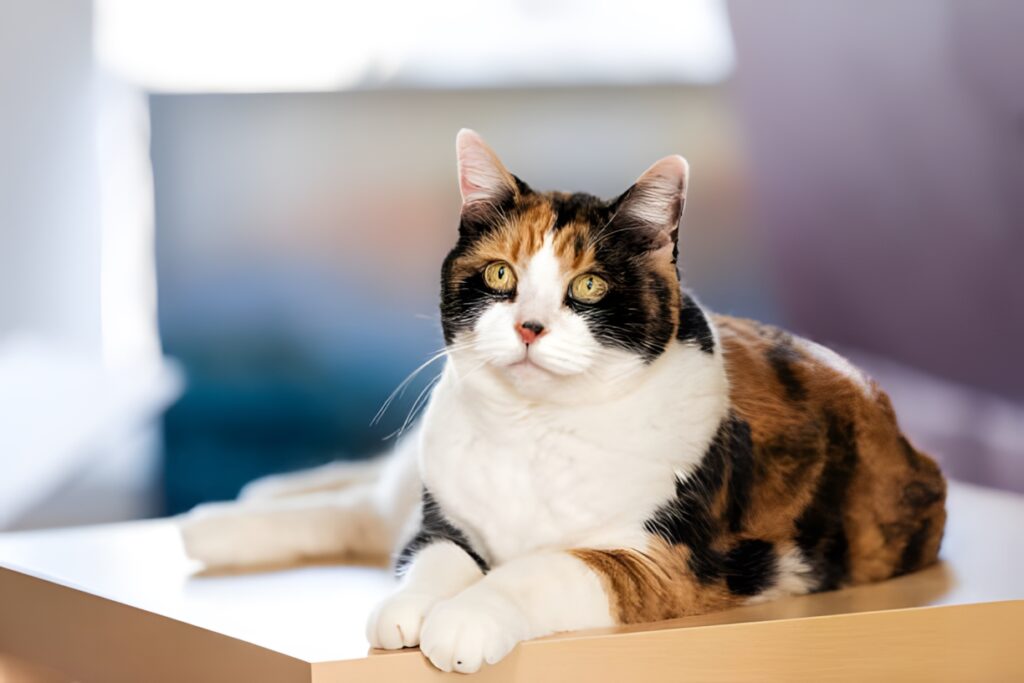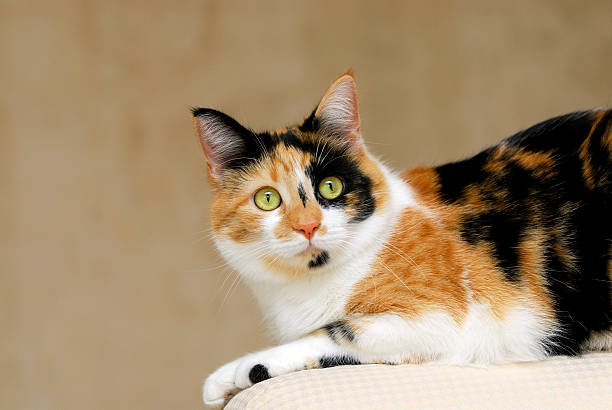Calico cats have captured the hearts of many with their striking appearance and unique charm. These cats are not a specific breed but are recognized for their distinct coat pattern. The term “Calico Cats” refers to the beautiful combination of colors—typically orange, black, and white—that adorn their fur. This captivating appearance makes Calico Cats one of the most beloved cats around the world.
What Makes Calico Cats Special?
These cats are special because of their incredible coat color variations. Despite their popularity, they are not a breed themselves. Instead, the term “Calico Cats” describes any domestic cat with a tri-color coat pattern. The most common Calico Cats display a mix of orange, black, and white, although other color variations exist. The beautiful blend of colors gives Calico Cats their unique and memorable appearance.
Unique Appearance
Calicos are often called the most colorful cats due to their remarkable fur patterns. While the classic tri-color pattern is common, some cats have shades of cream, blue-black, and even chocolate brown. These cats can be found in various breeds, except solid-color and pointed breeds like the Bombay and Siamese. The distinct patches of color on Calico Cats make them stand out in any crowd, adding to their mystique.

Calico vs. Tortoiseshell Cats
It can be challenging to differentiate between Calico Cats and tortoiseshell cats. However, Calico Cats have distinctive solid patches of color, while tortoiseshell cats typically have colors interwoven throughout their coats. The solid patches in them help distinguish them from other cats with similar coloring. This characteristic adds another layer of uniqueness to the appearance of them.
Personality
Since Calico Cats are not a specific breed, their personalities can vary widely. Many Calicos develop unique traits based on their upbringing, socialization, and experiences. Some cats may exhibit a calm and loving demeanor, while others might display a more independent and sassy attitude. This unpredictability adds to the excitement of owning a Calico Cat. Each one is truly one of a kind.
The Genetics Behind Calico Cats
The fascinating genetics of these cats have been the subject of scientific research for years. The distinct patches of color are due to a phenomenon known as X-chromosome inactivation. The genetic process leads to the random activation and inactivation of color genes in them. This randomness results in the unique and varied coat patterns seen in Calico Cats. The genetics of these cats contribute to their rarity and special status.
Are Calico Cats Always Female?
Almost all calicos are female due to the way coat color is linked to the X chromosome. Female cats have two X chromosomes, allowing for the combination of different fur colors. Male cats are extremely rare because they typically have one X and one Y chromosome. When a male cat is born, it usually has an extra X chromosome, resulting in a rare genetic condition. This rarity makes male cats an even more fascinating topic.
Health and Lifespan
The average lifespan of these cat ranges from 12 to 16 years, depending on various factors. Female cats generally live longer than their male counterparts due to the genetic condition known as Klinefelter’s Syndrome. Male cats with this syndrome may experience health issues like joint pain and diabetes, which can shorten their lifespan. However, with proper care, all Calico Cats can enjoy a long and healthy life.
The Rarity of Male Calico Cats
Male Calico Cats are extremely rare, with only 1 in 3,000 cats being male. This rarity is due to the unique genetic makeup required for a male cat to display the Calico pattern. The majority of Calico Cats are female, making male Calico Cats a rare and special find. Despite their rarity, male Calico Cats can lead healthy lives with the right care and attention.
Calico Cats Around the World
Calico Cats are not only admired in the United States but also hold cultural significance in other parts of the world. In Japan, the famous “Beckoning Cat” character is based on a Calico Cat. Calico Cats are also considered lucky charms in many cultures due to their rarity and unique appearance. The global admiration for Calico Cats highlights their special place in the hearts of cat lovers everywhere.
Fun Facts About Calico Cats
These cats have a rich history and are surrounded by fascinating facts. For instance, Calico Cats were declared the official state cat of Maryland in 2001 due to their coat’s resemblance to the Baltimore Oriole. Additionally, Calico Cats are often seen as symbols of good luck and are sometimes referred to as “money cats” in the United States. These fun facts add to the allure of owning a Calico Cat.
Calico Cats vs. Tabbies
Calico Cats are often confused with tabby cats, but there are distinct differences. While Calico Cats have a tri-color coat pattern, tabby cats usually have an “M” marking on their foreheads and distinctive stripes. The absence of this marking is a clear way to identify a Calico Cat. Understanding these differences helps in appreciating the unique beauty of Calico Cats.
Caring
Caring for it involves providing them with a nutritious diet, regular veterinary care, and a loving environment. Calico Cats, like all cats, thrive in homes where they feel safe and secure. Their unique personalities require attentive care tailored to their individual needs. Ensuring your Calico Cat receives the best care will help them lead a happy and healthy life.
Conclusion
These cats are truly one of a kind, with their beautiful coats, fascinating genetics, and vibrant personalities. Whether you are a long-time cat owner or new to the world of cats, Calicos offer a unique and rewarding experience. Their rarity and special traits make them a beloved pet choice for many. Understanding and appreciating what makes Calico Cats special can enhance the joy of having one as part of your family.
